Update 12/3/2025 – Simba is no longer available for purchase online in Canada. According to the Simba Canada website, Simba is still sold at Sleep Country. However, Sleep Country only appears to carry the Simba 2500 model.

Best For
- Excellent cooling performance
- Sleepers looking for zoned support layers
- Hybrid design with microcoil layer
Considerations
- No returns, $99 exchange fee
- May not be suitable for heavy stomach or back sleepers
- Manufactured and shipped from Canada
Our Verdict
The Simba Hybrid 2500 mattress is 12″ foam mattress made up of graphite poly foam, a layer of micro coils, regular poly foam, and zoned support foam. Despite having “hybrid” in its name, we do not consider the 1″ of micro coils in the comfort layer to be enough to call it one.
Hybrids are distinguished by a support coil unit typically 6-8″ thick and located at the bottom of the mattress. This mattress is also sold in the UK, France, and Spain with slight variations to the mattress for each region.
The Hybrid 2500 has a standard medium firm, 6 out of 10 firmness rating along with minimal sinkage and high bounce. This gives the mattress a comfortable feel that is easy to move around on.
The Simba Hybrid 2500 has an overall performance score of 8.60, ranking it among the bottom 44% of all mattresses tested to date. For a foam mattress, it is among the top 44% in its category. However, a queen-size costs C$2,199, C$595 or 37% more than the average foam mattress.
Overall, I think the feel, performance, and material quality are excellent. The Simba is a solid foam mattress by any definition. However, to still be selling a mattress online without a “no-questions refund policy” in this market just seems silly. It’s become such a standard part of every online mattress that it’s hard to imagine anyone being happy about having to take that risk.
Type: Foam
Firmness: Medium-Firm (6)
Best For: All Sleeping Positions, All Body Weights
In This Review
Performance Tests | Firmness | Support & Sleeping Positions | Design | Materials | Comparisons | FAQs
Simba sells mattresses in 4 countries. The models are all similar, but there are some differences. For this review, we are focusing specifically on the Simba Hybrid 2500 made for Simba Canada.
Performance Tests
At NapLab, we put each mattress to the test.
We test 10 different factors that impact the performance, comfort, and value of the mattress. We then take the results of that test and compare to every mattress we’ve tested to date.
Check out the full performance table below to see how this mattress ranks:
| Factor | Simba Hybrid 2500 | Average |
|---|---|---|
| Overall Score | 8.60 | 8.55 |
| Price (Queen) | C$2,199 | $1,604 (Foam only) |
| Cooling – Score | 9.0 | 8.7 |
| Sinkage – Depth | 1.91″ | 2.15″ |
| Sinkage – Feel | Minimal | Moderate |
| Motion Transfer – Score | 10 | 8.2 |
| Motion Transfer – Acceleration | 3.70 m/s² | 8.79 m/s² |
| Response Time – Score | 7.8 | 8.9 |
| Response Time – Mostly Recovered | 0.5 sec. | 0.4 sec. |
| Response Time – Fully Recovered | 1.3 sec. | 0.9 sec. |
| Bounce – Height | 11.42″ | 9.51″ |
| Bounce – Feel | High | Moderate |
| Edge Support – Score | 8.6 | 8.6 |
| Edge Support – Sitting | 4.50″ | 4.04″ |
| Edge Support – Lying | Excellent | Good |
| Sex – Score | 9.3 | 8.4 |
| Pressure Relief – Score | 9.0 | 8.7 |
| Comfort Layer Thickness | 5.8″ | 4.1″ |
| Mattress Thickness | 12″ | 12.0″ |
| Off-Gassing – Score | 8.6 | 8.2 |
| Off-Gassing – Smell | Strong | Strong |
| Off-Gassing – Days | 5 days | 6 days |
| Company – Score | 5.0 | 8.8 |
| Trial | 100 nights | 177 nights |
| Warranty | 10 years | 25% have lifetime warranties, average of other 75% of mattresses is 13 years |
How is Simba Hybrid Different?
The Simba Hybrid has a slightly worse than average performance and a higher price tag as well—37% more than the average foam mattress for an increase of $595 (for a queen-size mattress).
Advantages
Other advantages besides price include slightly better cooling performance, extremely low levels of motion transfer, better sex performance, and a thicker comfort layer than average.
Neutral Factors
This mattress has 11% less sinkage than average and 20% more bounce than average. Both bounce and sinkage are more preferential factors than “good vs. bad”, but still worth considering.
Disadvantages
The Simba Hybrid struggles a bit with poorer edge support than average, as well as slightly slower material response time. In addition, only allowing for exchanges with a $99 fee isn’t favorable for consumers.
Cooling Test
Cooling performance on the Simba Hybrid 2500 mattress was excellent. In our cooling tests, I never felt any significant heat retention or heat build-up around my body.
Baseline Temp.
77.0° F
Max Temp.
88.5° F
Ending Temp.
81.1° F
The Simba mattress breathed well, released heat, and remained comfortably cool. The material design and layering help to improve cooling and breathability. The top layer of graphite foam has a visibly large open cellular structure.

This type of foam structure allows air to more easily penetrate the foam, improving cool.
Max Temp.

Ending Temp
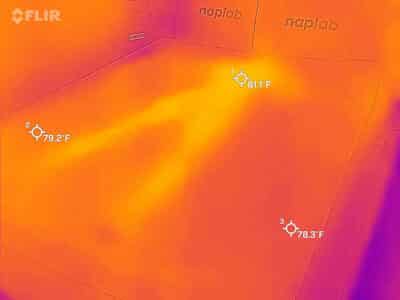
- Baseline Temperature – the temperature of the mattress before anyone lies on it
- Maximum Temperature (0 minute) – the temperature of the mattress after lying on it for 15 minutes
- Ending Temperature (5 minute) – the temperature of the mattress after being lied upon and having no one on it for 5 minutes
In addition, the base foam is a zoned foam. For cooling, the large cutouts allow air to flow through the mattress.
Lastly, the microcoil layer also increases airflow. All three of these design factors have a positive impact on the total cooling experience of the Simba.
Looking at our objective data we saw a maximum temperature of 88.5°F. After heating the mattress with body heat for 15 minutes and then getting off the mattress we saw a decline of 3.6° during the first 1 minute, from 88.5 to 84.9°.
Heat Dissipation Over Time
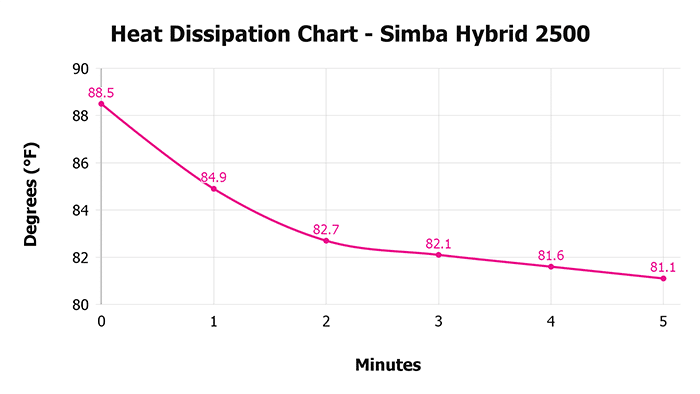
This is about average compared to all other mattresses we’ve tested to date. By the 5-minute measurement mark, the Simba mattress had declined to 81.1°.
The heat dissipation curve is good, but not overly impressive. It has a gradual and continual heat decline over the entire 5-minute measurement period, with fairly typical temperature declines from minute to minute.
Sinkage Test
The Simba Hybrid 2500 mattress has a minimal to moderate level of sinkage. In our tests, we measured 1.91” of sinkage.
Sinkage Depth
1.91″
Sinkage Feel
Minimal
Body Contour
Dramatic
The level of sinkage is documented in the image below.
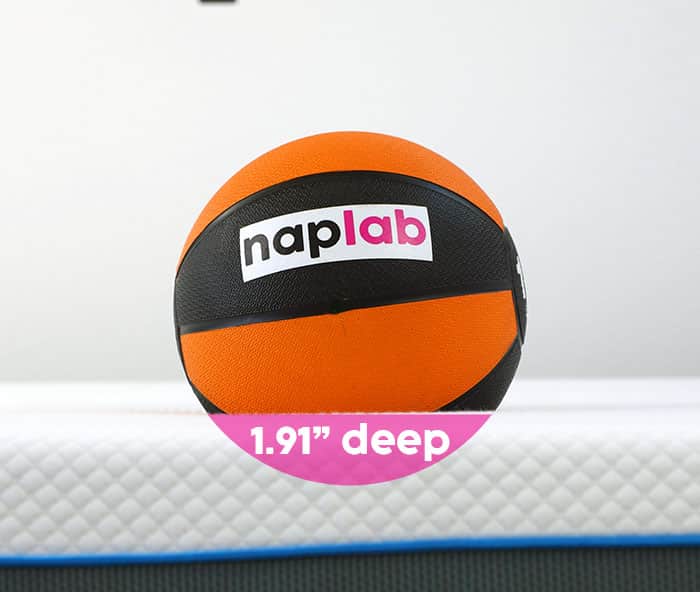
This is notably lower than the average sinkage across all of our mattress tests to date, which is 2.15”. The Simba has a relatively thin comfort layer. There is 2.25” of strict comfort foams and 3.5” of transitional support / comfort foam.
It seems that the 3.5” transitional poly foam layer is really creating quite a lot of pushback and support. While this is great in terms of support, it does mean sinkage is more restrained, and may not be ideal for all side sleepers.
Motion Transfer Test
Motion transfer on the Simba Hybrid 2500 is extremely low. In our accelerometer motion transfer tests, we measured 3.70 m/s² of acceleration.
This is significantly better (58% less) than the average motion transfer based on all of our mattress tests to date, which is 8.79 m/s².
Accel. Range
3.70 m/s²
Motion Duration
0.73 seconds
The level of motion transfer is documented in the video below.
While the Simba does include microcoils, microcoils don’t create nearly the same level of motion transfer a more typical pocketed coil mattress will.
As a result, the Simba’s motion transfer level looks far more like an all-foam mattress than a hybrid. Looking at our motion transfer chart (which visualizes our accelerometer data), we can see the highest motion levels dissipate by 0.35 seconds.
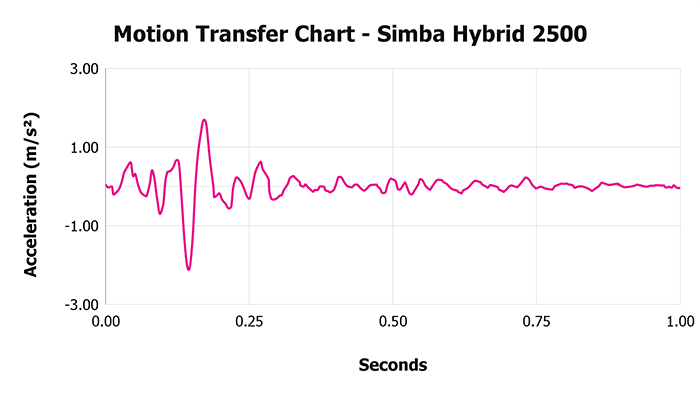
A slight to moderate level of motion persists until 0.73 seconds, after which, motion returns to near-zero levels. The motion duration and motion peaks are both very low. Overall, very low motion transfer for Simba.
Response Test
Response time on the Simba Hybrid 2500 is moderately fast. In our tests, we measured a mostly recovered response time 0.5 seconds and a fully material recovery of 1.3 seconds.
Mostly Recovered
0.5 sec.
Complete Recovery
1.3 sec.
This is about average compared to all of our mattress tests to date. Even so, being average is plenty fast enough for the vast majority of sleepers.
The level of responsiveness is documented in the video below.
On average (across all of our mattress tests to date) we see a mostly recovered response time of 0.4 seconds and an average full material recovery of 0.8 seconds. The poly foam layers and microcoils bounce back to shape extremely quickly.
While this isn’t the fastest response time we’ve tested to date (which is 0.2 seconds), it is still extremely quick. Most sleepers should find response to be a non-issue.
Bounce Test
The Simba Hybrid 2500 has a very high level of bounce. In our tests, we measured a total bounce height of 11.42”.
Max. Depth
6.0″
Max. Rebound
5.42″
Total Bounce
11.42″
This is notably more than the average bounce height, which is 9.65” (based on all of our tests to date). Bounce is a bit of a preferential factor.
Max. Sinkage Depth

Max Bounce Height

The level of bounce is also documented in the video below.
Although bounce is largely based on personal preference, more bounce makes the mattress easier to move around on, gives it a more traditional feel, and improves sex. At 11.42” the Simba has plenty of bounce.
Edge Support Test
The edge support on the Simba Hybrid 2500 is good, but not great. In our tests, we measured 4.5” of compression while sitting directly on the edge of the mattress.
Max. Sinkage
4.50″
Lying Support
Excellent
Reinforced Edge
No
This is just slightly worse than the average edge compression, based on all of our mattress tests to date, which is 4.04” of compression.
The level of edge support while seated is documented in the images below.
Sitting, 140 lbs.

Sitting, 200 lbs.

The level of edge support while lying is documented in the images below.
Lying on Edge, 140 lbs.

Lying on Edge, 200 lbs.

Typically, I want to see 4.0” of sitting edge compression or less. While sitting edge support leaves something to be desired, edge support while lying directly on the edge was excellent. I felt fully supported while lying directly on the edge in all sleeping positions.
Sex Test
The Simba Hybrid 2500 has excellent sex performance with little room for improvement. The best mattresses for sex have high bounce, good edge support, quiet materials, and good pressure relief and cooling.
These 5 factors make up the NapLab sex performance score.
| Sex Factor | Factor Weight | Score | Rating |
|---|---|---|---|
| Bounce | 65% | 9.6 | Very High |
| Edge Support | 20% | 8.1 | Good |
| Noise | 5% | 10 | Minimal |
| Pressure Relief | 5% | 9.0 | Excellent |
| Cooling | 5% | 9.0 | Excellent |
This is a very good score. Let’s walk through the factors that helped produce this score.
First is bounce—bounce is arguably the most important factor for sex and makes up 60% of the overall sex score. Bounce levels on the Simba were relatively high, which gave it a score of 10.

Edge support is good, but not great on this mattress with 4.5″ of sinkage when sitting directly on the edge. This is a little more than I like to see and brings the edge score down to 9.3.
Noise, pressure relief, and cooling were all non-factors really, and had good scores.
Pressure Relief Test
The Simba Hybrid 2500 has excellent pressure relief. The mattress has 2.25” of pure comfort material and another 3.5” of comfort / support transitional poly foam.
Comfort Layer
5.75″
Support Layer
6.25″
Those layers work together well with the zonal support layers to create fantastic pressure relief for most sleepers and sleeping positions.
While the top layer of foam is a poly foam, it still leans more towards more of a memory foam feel with respect to the contour and hug.
The Simba Hybrid 2500 creates a dramatic contouring effect around the body. This design fact, combined with the zonal support, allows for deeper sinkage in the midsection and hips.

For side sleepers in particular, this is ideal, as it helps to create a neutral spinal alignment while sleeping. However, I could see that deeper mid-section sinkage creating support problems for stomach and back sleepers.
Off-Gassing Test
The Simba Hybrid 2500 had a strong off-gassing smell upon immediately unboxing the mattress.
Initial Smell Strength
Strong
Off-Gassing Period
5 days
That strong odor lingered for 5 days before dissipating. After the 5th day, the smell was no longer significant.

On average, the mattresses we’ve tested smell for 6.42 days. So the Simba is a bit faster than average, but nothing too out of the ordinary.
Company
The company score takes a look at factors that may influence your experience with the mattress.
Factors include length of the trial period, warranty, shipping / return costs, and country of origin.
| Company Factor | Factor Weight | Score | Data |
|---|---|---|---|
| Returns | 40% | 0.0 | No / Very limited returns |
| Trial Period | 30% | 8.0 | 100 nights |
| Warranty | 20% | 8.0 | 10 years |
| Shipping | 10% | 10 | $0 |
| Country of Origin | 0% | Global |
Simba offers a 100-night trial period with a 10-year warranty. This trial period is 60 nights shorter than the average trial period (160 nights).
With the recent change to only being sold at Sleep Country, you can only exchange the mattress, and there are no returns offered. Additionally, there is a $99 exchange fee if you choose to go through the process.
Only allowing exchanges with a return fee doesn’t favor the consumer. It reduces the level of confidence one might have when purchasing a mattress, as you are locked into limited options for returns.
How firm is the Simba?
The Simba mattress is available in one firmness that is around a 6 out of 10. Generally, this is a good pick for the widest range of sleepers.

Support & Sleeping Positions
Support on the Simba Hybrid 2500 was excellent. In all of our tests, I felt well-supported in all sleeping positions.
| Support Factor | Data |
|---|---|
| Comfort Layer | 5.75″ |
| Support Layer | 6.25″ |
| Firmness | Medium-Firm |
| Body Contour | Dramatic |
| Zoned Support | Yes |
| Reinforced Edge | No |
The Simba’s base foam layer is cut with channels to enable zonal support. This creates more support where you need it and less where you don’t.
Zonal support is helpful for all sleeping positions, but especially side sleepers.
My only concern with respect to support is that heavier-weight stomach and back sleepers may find the zonal support detrimental.
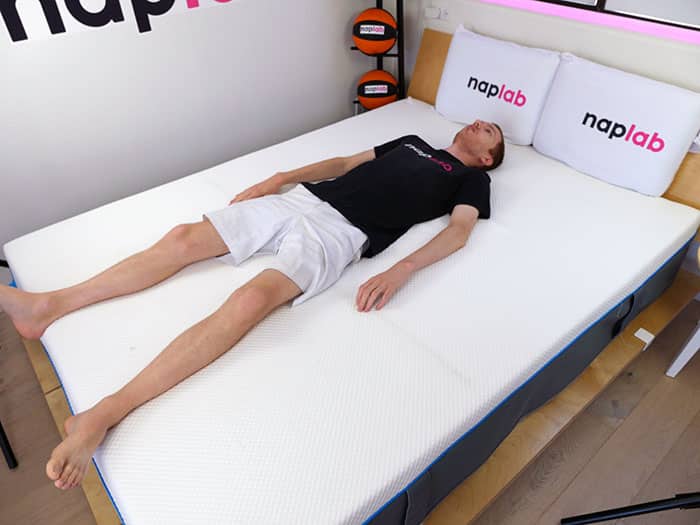
This is because the middle zone is allowing for more sinkage, which is great for side sleepers, but not for stomach / back sleepers.
As a result, some stomach and back sleepers may find it doesn’t create enough support in the middle of the mattress.
Who is Simba Hybrid 2500 best for?
| Sleeper Weight | Stomach Sleepers | Side Sleepers | Back Sleepers |
|---|---|---|---|
| Under 150 lbs. | Yes | Yes | Yes |
| 150-250 lbs. | Yes | Yes | Yes |
| 250-300 lbs. | Maybe | Yes | Maybe |
Design
The Simba Hybrid 2500 is a foam mattress that uses layers of poly foam as well as micro coils for support and comfort. It has a thicker profile than many other mattresses we’ve tested and also has a thicker comfort layer.
| Design Factor | Data |
|---|---|
| Type | Foam |
| Thickness | 12″ |
| Cover Type | Thin |
| Weight | 86 lbs. |
| Has Handles | Yes |
| Fiberglass-Free | Yes |
| Ships in a Box | Yes |
Materials
Below the cover, there are four distinct layers on the Simba 2500 Hybrid mattress.
| Layer Type | Thickness | Layer Specs |
|---|---|---|
| Poly Foam | 1.25″ (3.18 cm) | Not Available |
| Microcoils | 1.0″ (2.54 cm) | Not Available |
| Poly Foam | 3.5″ (8.89 cm) | Not Available |
| Support Foam | 6.25″ (15.88 cm) | Not Available |

The top two layers are true comfort layers, graphite poly foam and a thin layer of microcoil. The mid-level poly foam is a bit of a comfort layer and also a bit transitional, easing the sleeper into the support layer below.
The Cover
The cover of the Simba Hybrid is ultra-soft and stretchy. It is hypoallergenic as well, designed to keep your mattress fresh and cool.

The sides use a denser gray fabric with contrasting blue piping trim to separate the reinforced edges from the softness of the top.

There are also four handles on the Simba, two on each side. The handles on the Simba are a bit wider than other handles we typically see—they feel very strong and are user-friendly.
The Comfort Layer
After the cover is the comfort layer, which is primarily 3 layers thick.
- Graphite poly foam: The top layer is the graphite poly foam. This layer is great for response and cooling. Thickness: ~3 cm (or) ~1.25″
- Microcoils: The middle layer is a thin layer of microcoils that are designed to adjust with great accuracy around the contours of the body. Microcoils are great for limiting motion transfer, yet also improving bounce. Thickness: ~2.5 cm (or) ~1.0″
- Poly foam: The bottom layer of comfort layer acts a bit like a transitional layer before the support foam. It’s denser than the top poly foam, yet still provides softness and support. Thickness: ~9 cm (or) ~3.5″

These three layers work together to provide softness, support, contour, and pressure relief for the sleeper.
The Support Layer
The bottom layer is a high-density foam that supports the layers above as well as the weight of the sleepers.
This layer uses a 7-zoned system that allows for pressure relief and sinkage in the midsection of the mattress.

While this is a really nice feature for side sleepers, it may be less than ideal for stomach or back sleepers.
Product Evolution
The Simba Hybrid 2500 mattress was recently launched in 2021 and has undergone no significant changes since its launch.
I will add that other versions of the Simba Hybrid have been around since 2018. These subsequent models are very similar to the Hybrid 2500, with slight differences in the feel, materials, and company policies.

For example, the UK version of the Simba offers an extended trial period (200 nights) as well as more size options available to suit the UK market.
Other Mattresses to Consider
Still not sure if the Simba Hybrid 2500 is right for you? Check out some of our other top recommendations below for other mattresses to consider.
For Softer Feel

Logan & Cove
2 Firmness Options
The Logan & Cove is another option for Canadian sleepers. This mattress has a 14″ profile with both foam and coils. It is available in two firmness levels—Medium Plush (4) or Luxury Firm (5.5)
For Less Bounce
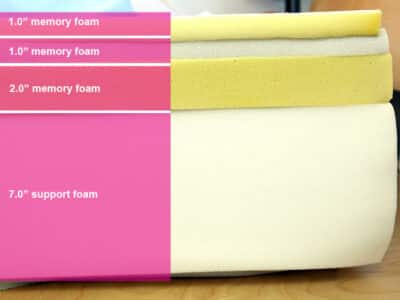
Novosbed
5″ of Memory Foam
The Novosbed mattress is another Candian mattress. This one has an 11″ profile, 1″ less than the Simba, and uses memory foam. This gives it much less bounce and ultra-low motion transfer.
Ultra Low Budget
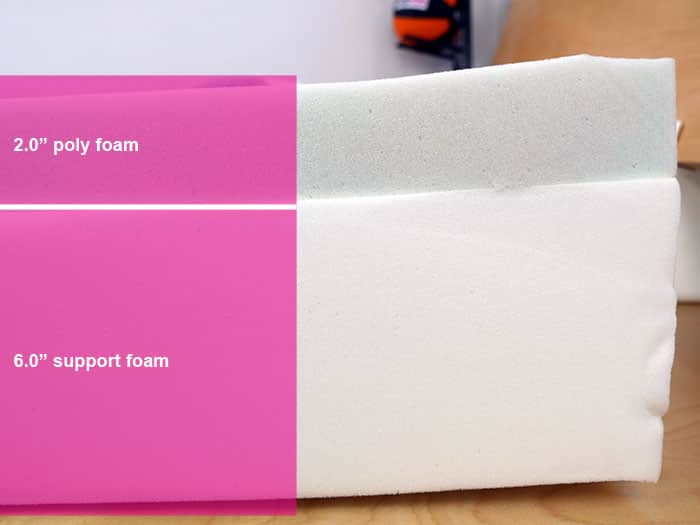
Full Moon
2″ Comfort Layer
The Full Moon has is an ultra budget-friendly mattress. It uses only 2.0″ of comfort material, making it less than great for side sleepers. Even so, if you’re a back or stack sleeper and want a Queen for $450 this is it.
Frequently Asked Questions
Still have questions on the Simba Hybrid 2500? Check out our list of popular FAQs below.
The cost of a Simba Hybrid 2500 mattress varies depending on what size you’re looking for. Here are the current prices, with any sales or promotions reflected below:
Twin: $1,099 ($1,372 CAD)
Twin XL: $1,229 ($1,534 CAD)
Full: $1,499 ($1,871 CAD)
Queen: $1,649 ($2,058 CAD)
King: $1,879 ($2,345 CAD)
*Note: Sales prices are subject to change without notice or warning.
The Simba Hybrid 2500 is a medium-firm mattress—a 6 out of 10 on the firmness scale, where 10 is the most firm.
The Endy mattress is another popular mattress choice in Canada. Unlike the Simba, Endy is not a hybrid (meaning there are no coils). Another difference is that the Endy has a washable cover that zips off.
The Simba Hybrid 2500 is made in Toronto, Canada. Headquarters for the brand is located in London, UK.
In most cases, yes, the Simda Hybrid 2500 is a great choice for side sleepers. The 7-zoned support layer offers improved pressure relief at the midsection which is especially beneficial for side sleepers.



